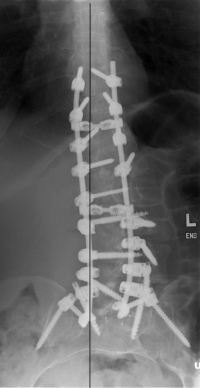Scoliosis Surgery Overview
Scoliosis surgery is as varied as the types of scoliosis that present to the office. Scoliosis by definition is a curve in the front to back plane of greater than 10 degrees. Of course, a 10 degree scoliosis by itself does not need surgery. For terms of this topic, there are two types of scoliosis that need surgery, idiopathic and degenerative. The idiopathic type is normally found in adolescent children and is normally painless.
There are certain curves (by location and degree of curve) that are known to progress. The surgery is necessary to prevent the expected progression of the curve. In addition, the scoliosis deformity of the spine can cause eventual deformity of the “normal” spine above and below the deformity which is another reason to fix the curve.
The necessity for scoliosis surgery in adults is normally due to degenerative spinal pain and from a breakdown of vertebral segments causing any of the conditions found in surgery section under the lumbar spine (degenerative spondylolysthesis, foramenal collapse and many others).
The scoliosis surgery is designed to take a deformed spine, straighten it somewhat and fix it so that the spinal curve will not progress. Essentially, in kids, the deformed but movable spine is traded for a straightened but stiff spine. In adults, the spine is normally stiff and cannot be straightened as much. Flexibility is lost with aging and the vertebra themselves will deform over time.
The straightening is performed with screws that are placed into each vertebra, removal of the facets which loosens the spine and finally two rods which, when attached to the screws, allows for a repositioning of the spine. The rods and screws hold the spine in the appropriate position while the fusion takes place. In most cases, after about 8-12 months the fusion is complete. There is no need normally to remove the instrumentation.
Scoliosis surgery for adults is normally more complex than children as the spine is more degenerative, deformed and will not straighten as well. The complexity is that taking the deformed spine and straightening it can stretch a nerve root and create new nerve pain as some nerves will be tethered and not stretch to accommodate the newly straightened spine. This pain typically resolves after 2-3 months but occasionally can last longer.
To learn more about scoliosis surgery , please contact Dr. Donald Corenman, spine surgeon and back specialist offering diagnostic and surgical second opinions to patients in the USA and around the world.
Related Content
- Transforaminal Lumbar Interbody Fusion (TLIF)
- Posterolateral Fusion (PLF)
- Anterior Lumbar Interbody Fusion
- XLIF/DLIF Far lateral Interbody Fusion
- Microdiscectomy or Fusion?
- Minimally Invasive Lumbar Fusion
- Myths of Minimally Invasive Spine Surgery
- Myths of Laser Spine Surgery
- Indications for Lumbar Fusion

(Click to Enlarge Image) This is an AP X-ray (scoliogram) of a patient with severe scoliosis. The white line depicts the center of gravity line from the head. It should intersect the center of the pelvis. The black horizontal line demonstrates how far off the patients balance is. The amount of energy expended necessary to walk made her use a walker for balance.

(Click to Enlarge Image) This is a post-operative X-ray of the results of a scoliosis surgery. Here you can see that the black line is the new center of gravity line for this patient. She is balanced and can walk without aids. The rods and screws seen are a temporary scaffolding to hold the patient in line while the fusion takes place. After solid fusion, the metal is superfluous.


